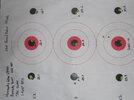Varminterror
Member
- Joined
- Jul 17, 2016
- Messages
- 14,893
Top row right connects to bottom row left. 41.0 to 42.4, every 0.2. The top row drops from 1 to 3, then rises again at 4, and is relatively flat 4-6, then falls again from 6 to 8. So that tells me there is more vertical consistency for 6-8 than anywhere else. Crossreferencing this with the velocity data, there was only a few fps difference between all shots for 4 and 5, then a marked jump for 6, so the node is really within 4-5, with 6 outside of the edge.
This is a 100yrd target, which isn't ideal, but that's what was available during that day, and this was a repeat of tests done many times before. If I were doing this for a new barrel, I'd shoot this test at 500-600yrds, or at LEAST 300yrds, to help ensure those slight vertical shifts are dominated by the load, not by mechanical errors at the rifle.
This is a 100yrd target, which isn't ideal, but that's what was available during that day, and this was a repeat of tests done many times before. If I were doing this for a new barrel, I'd shoot this test at 500-600yrds, or at LEAST 300yrds, to help ensure those slight vertical shifts are dominated by the load, not by mechanical errors at the rifle.





